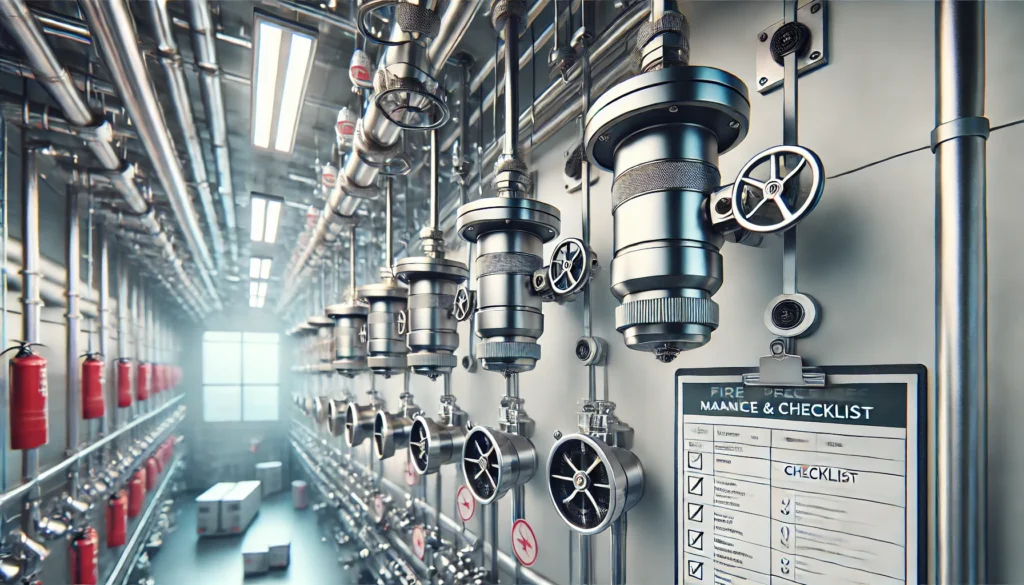Regular maintenance of fire suppression nozzles is essential for ensuring the effectiveness, reliability, and compliance of the system with safety regulations. A structured inspection, cleaning, and maintenance approach minimizes risks and enhances system performance.
1. Routine Inspection Schedule
| Frequency | Inspection Task |
|---|---|
| Weekly | Perform a visual inspection for physical damage, clogging, or misalignment. |
| Monthly | Check nozzle positioning and ensure there are no obstructions. |
| Quarterly | Clean nozzles and check water pressure to maintain proper spray patterns. |
| Annually | Conduct full system testing, including nozzle flow test and alignment verification. |
| Every 5 Years | Perform an internal inspection of nozzles, pipes, and spray heads for corrosion or wear. |
2. Nozzle Maintenance Procedure
A. Visual Inspection
- Check for physical damage, corrosion, or clogging.
- Ensure nozzles are properly aligned with designated coverage areas.
- Inspect seals and gaskets for leaks or deterioration.
B. Cleaning Nozzles
- Remove dust, dirt, or residue using a soft brush or compressed air.
- Flush clogged nozzles with clean water or manufacturer-approved solvent.
- Avoid abrasive tools that could damage the nozzle orifice.
C. Testing Spray Patterns
- Conduct a water flow test to verify the correct spray pattern.
- Use a pressure gauge to ensure the nozzle receives adequate water pressure.
- If water distribution is uneven, adjust or replace the nozzle.
D. Checking Nozzle Seals and Connections
- Inspect threaded connections and gaskets for leaks.
- Tighten loose fittings carefully to prevent cracks.
- Replace worn-out seals to avoid leakage.
E. Corrosion Prevention
- Apply anti-corrosion coating for metallic nozzles, if specified by the manufacturer.
- Ensure pipes and fittings are free from rust or sediment that could clog nozzles.
- In coastal or humid environments, inspect for salt buildup and oxidation.
3. Special Maintenance Tips
- Use only manufacturer-approved cleaning agents to avoid nozzle damage.
- Disable the fire suppression system before conducting any maintenance.
- Document all inspections and maintenance activities for compliance with NFPA 25 and local regulations.
- Replace defective nozzles immediately to ensure system integrity.
- Train personnel on proper handling, maintenance, and emergency troubleshooting.
4. Fire Suppression Nozzle Maintenance Checklist
| Inspection Task | Frequency |
| Check for physical damage or corrosion on nozzles. | Weekly |
| Ensure nozzles are properly aligned with coverage area. | Weekly |
| Inspect for obstructions (dust, dirt, residue, grease). | Weekly |
| Flush clogged nozzles with clean water or approved solvent. | Monthly |
| Perform a water flow test to verify spray pattern. | Quarterly |
| Check water pressure at the nozzle using a pressure gauge. | Quarterly |
| Inspect seals and gaskets for wear or leaks. | Quarterly |
| Verify proper tightening of nozzle fittings. | Quarterly |
| Apply anti-corrosion coating (if applicable). | Annually |
| Ensure pipes and fittings are rust-free. | Annually |
| Check for salt buildup in humid/coastal areas. | Annually |
| Disable fire suppression system before performing maintenance. | Before Maintenance |
| Replace any defective nozzles immediately. | As Needed |
| Record findings and actions in the maintenance log. | Every Inspection |
| Ensure trained personnel handle nozzle maintenance. | Ongoing |
